Homemade pie crusts are about a thousand times more flavorful, flaky, and tender than the store-bought kind. It takes a little bit of extra work to get a perfect pie crust, but it absolutely does not need to be as intimidating as it may seem.
Until the dough comes together in a cohesive ball, it seems like something has gone wrong. Not to mention all of the frustrations when pie dough shrinks or loses its shape after baking. I’ve factored in as many potential pie crust woes into this recipe to make it as foolproof as possible.
I actually completely overhauled my pie crust recipe in 2020 to make it even more tender and flaky. I took a bunch of feedback I’d received over the years from readers to improve the recipe and I’m SO happy with the results. Take a look at just how FLAKY:
I spent weeks testing, experimenting, and researching different pie dough methods, tips, and tricks. Some worked, others didn’t.
I’m sharing a ton of tips that truly work in this post, so let’s go ahead and get right into the juicy stuff. (Or should I say flaky stuff?)
How to Make the Best Ever Pie Crust
For Flaky Pie Crust, Keep Everything COLD, Especially Your Butter
If your kitchen is above 73°F, you can refrigerate all of your ingredients and equipment including your bowl, rolling pin, and pie plate until it’s between 65-70°F (dip an instant-read thermometer into your flour to gauge the temperature). If it’s a hot day, or you have hot hands, you’re probably better off making your pie dough in a food processor.
If your kitchen is warm, fill freezer bags with ice and a little water and set them on your work surface for 10 minutes to chill it before rolling out your pie dough. This will prevent the butter from becoming greasy as you work with the dough.
Pea-Sized vs. Large Chunks of Butter in Pie Dough
- The general rule of thumb is that smaller pieces of butter will result in a more mealy textured crust that holds up better to custard fillings.
- Larger chunks of butter will yield a flakier crust better suited for fruit fillings. Larger chunks also run the risk of creating pools of butter as your pie dough bakes.
- Overall, the differences can look relatively minor from a visual perspective once the crusts are baked.
- If you don’t have a ton of pie dough experience or confidence, I’d recommend small pieces of butter. It makes the dough much easier to work with!
- Take a look at what a difference it makes to use pea-sized vs. large chunks of butter in pie crust:
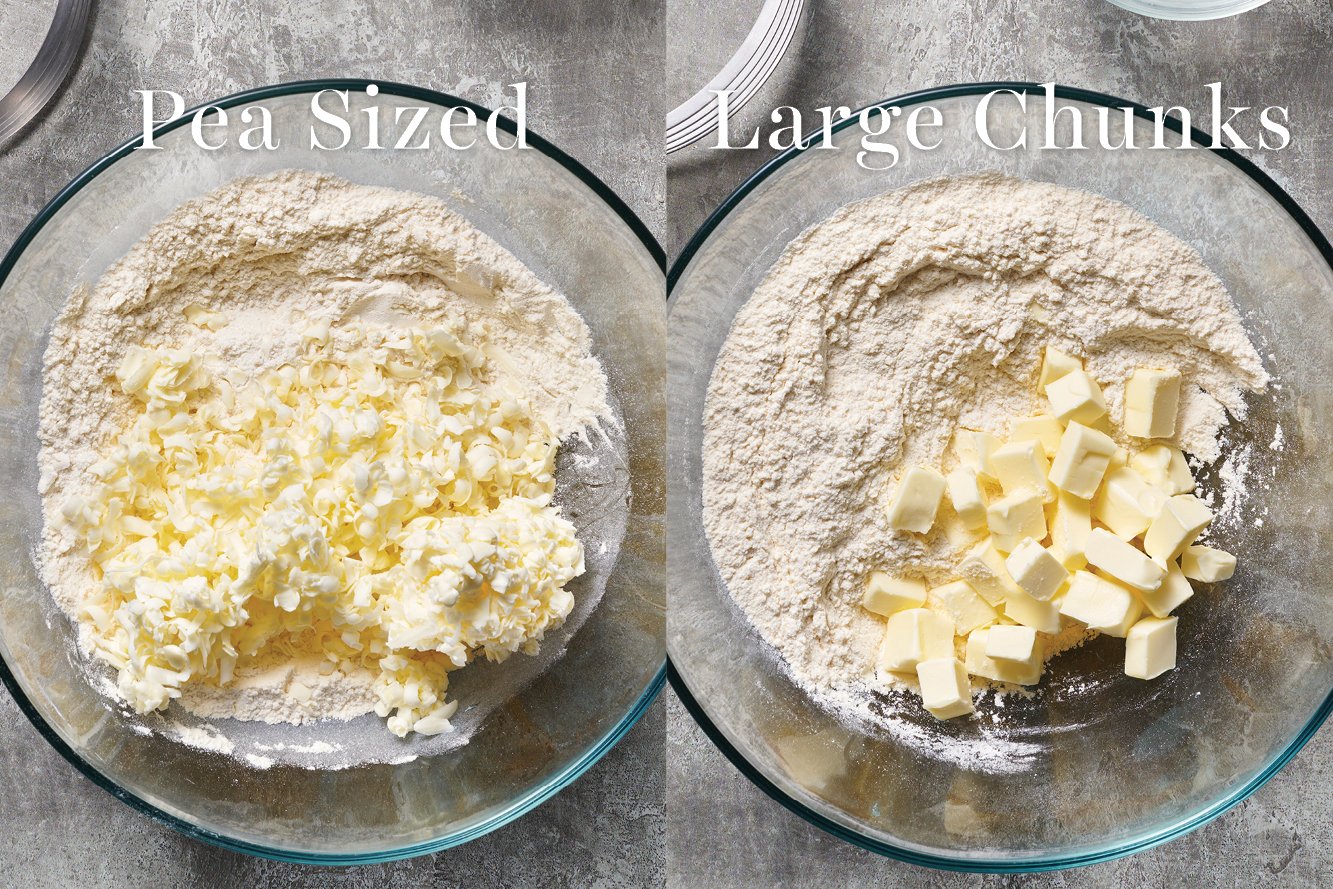
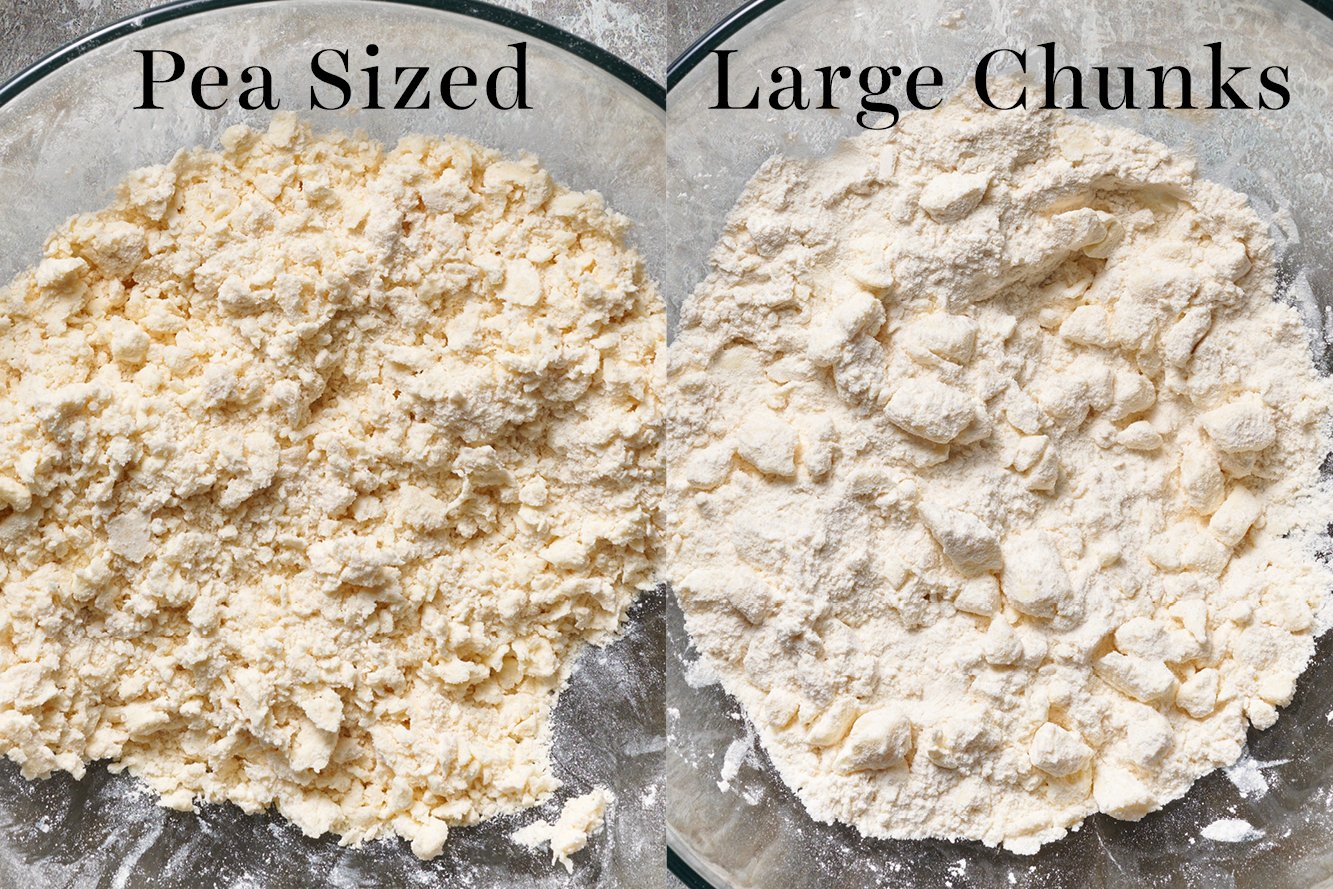
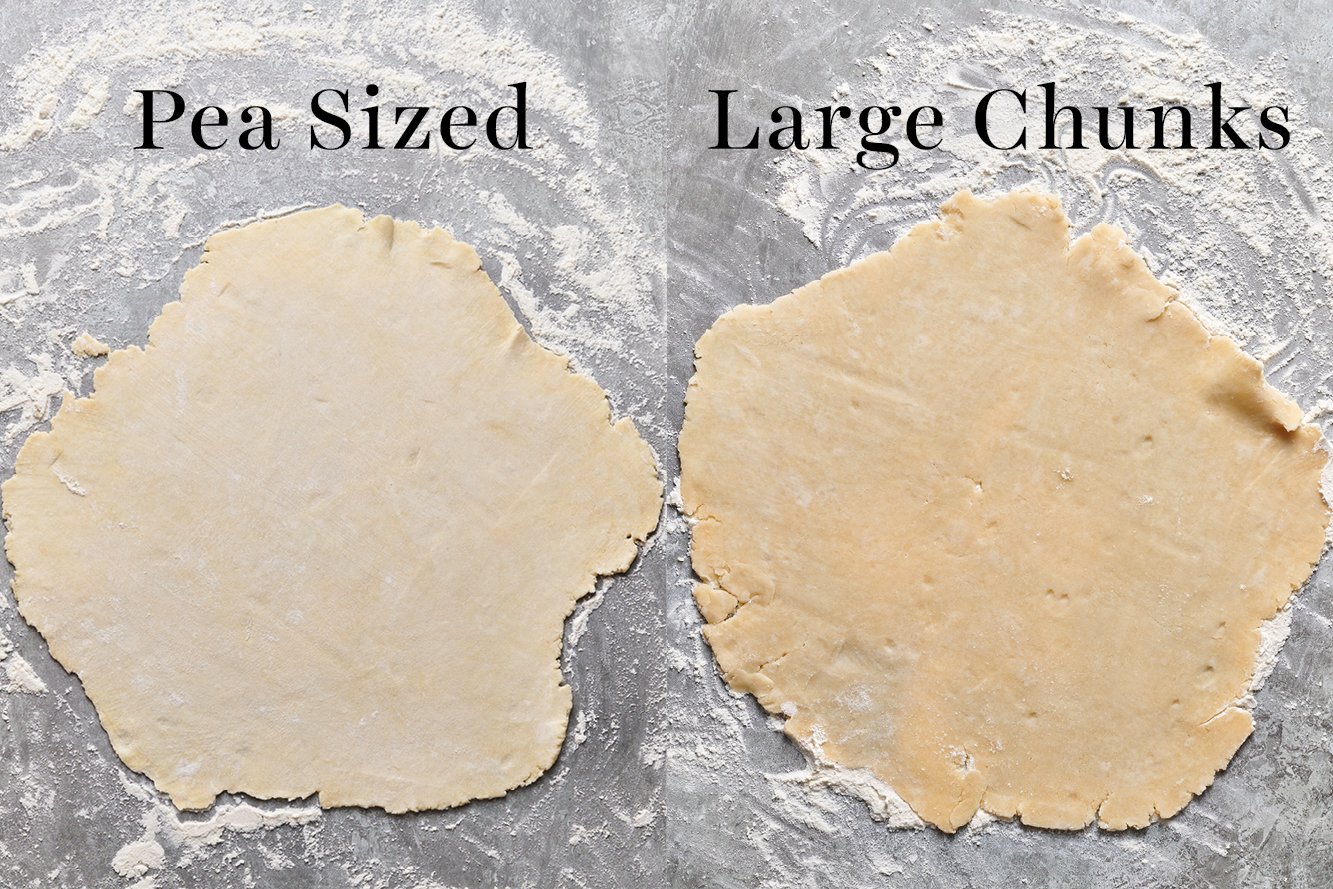
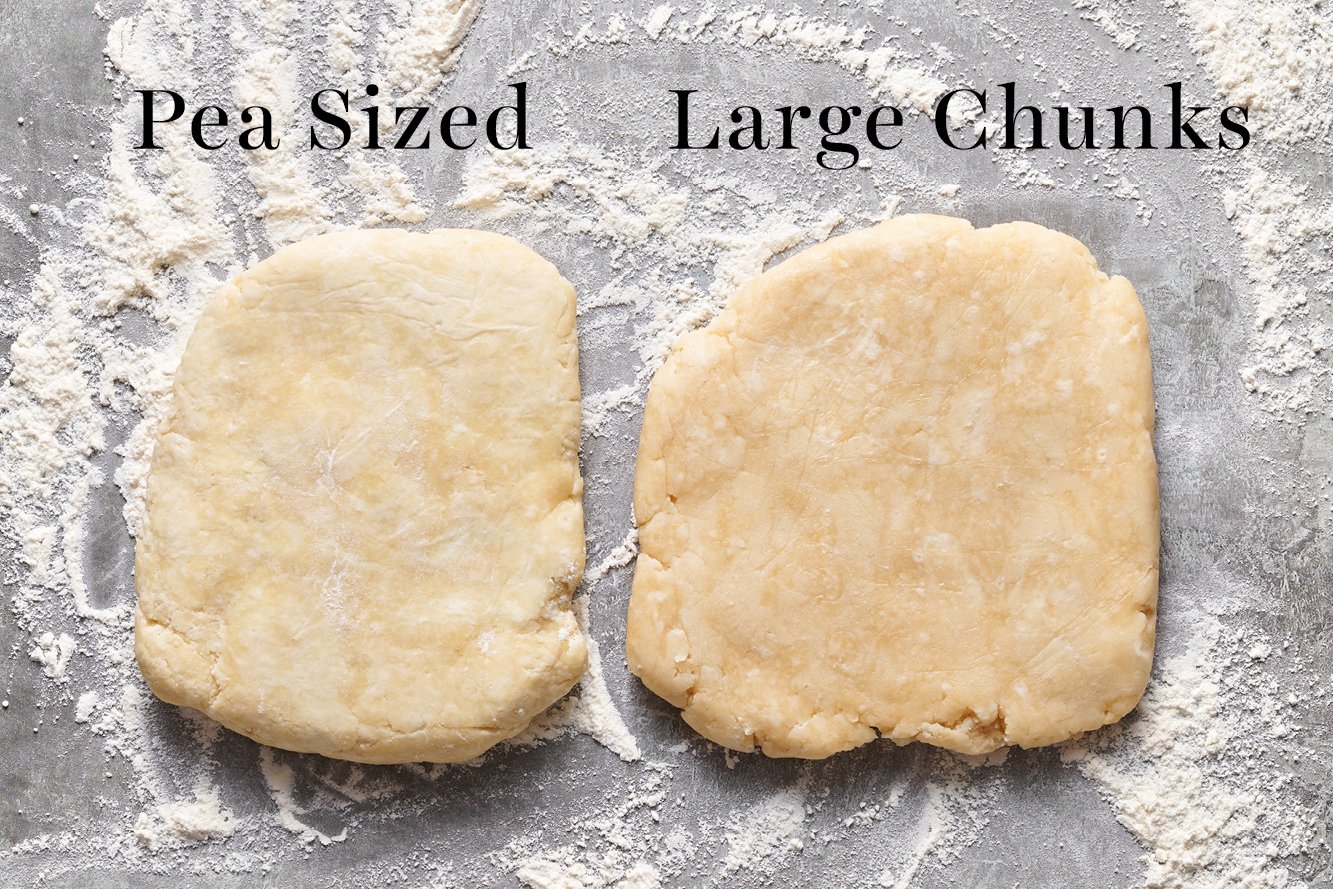
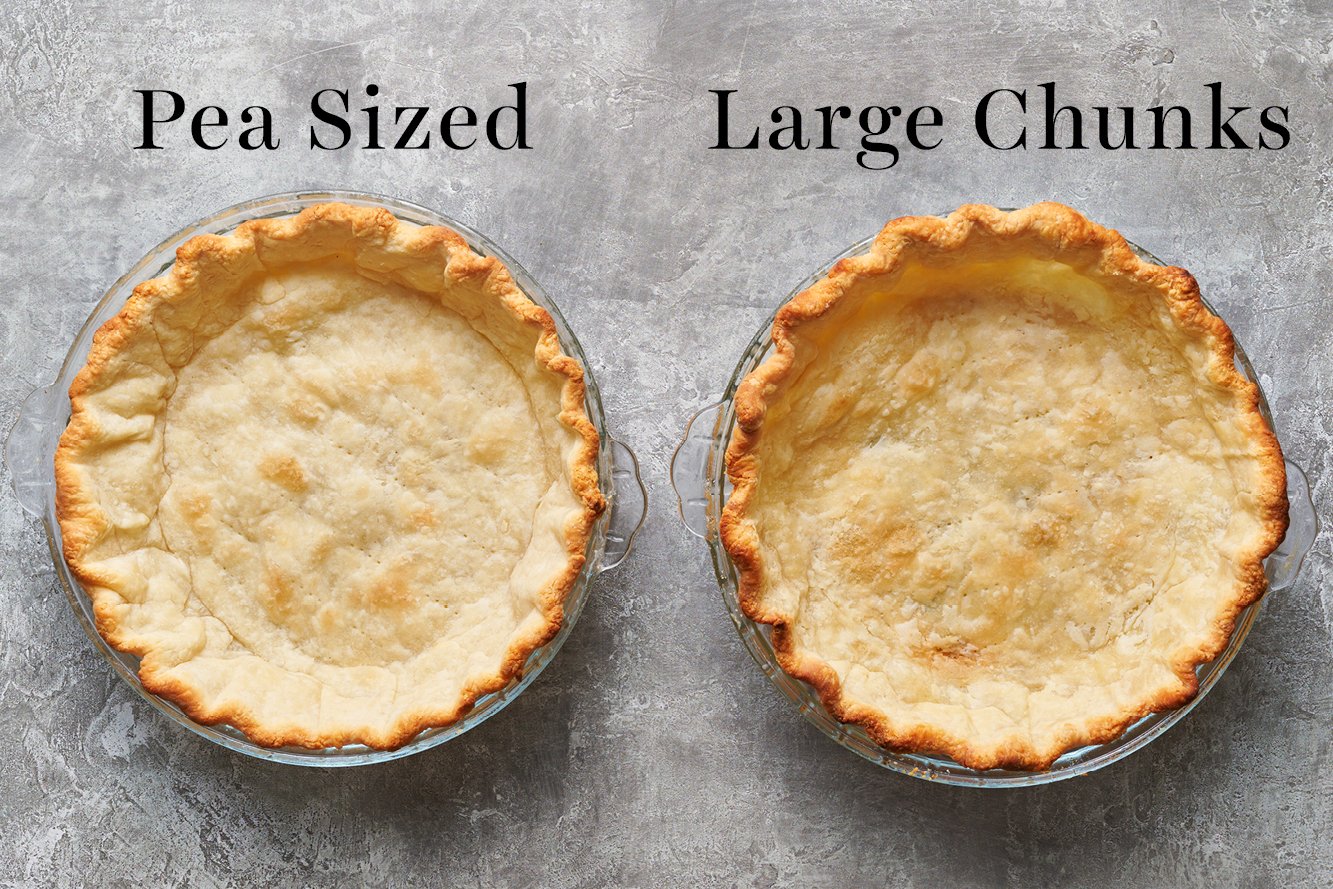
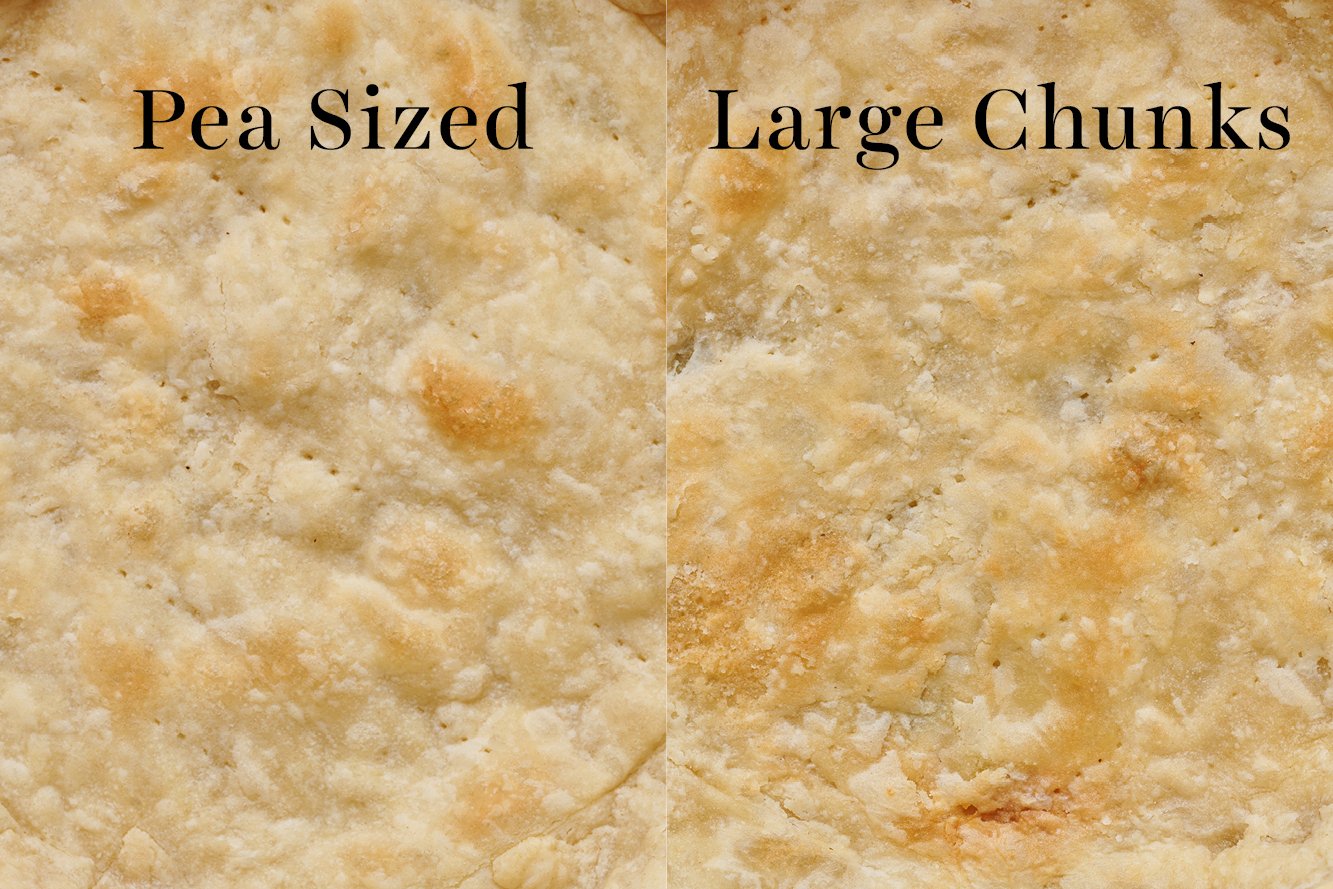
Cut the Butter Into Small Uniform Pieces
It should take just a couple of minutes to cut the butter into the flour mixture so you don’t risk the butter getting too hot. For this reason, it’s helpful to start out with pieces of butter that are already small in size. I’ve included several options for processing the butter below. My personal favorite is to grate it like cheese!
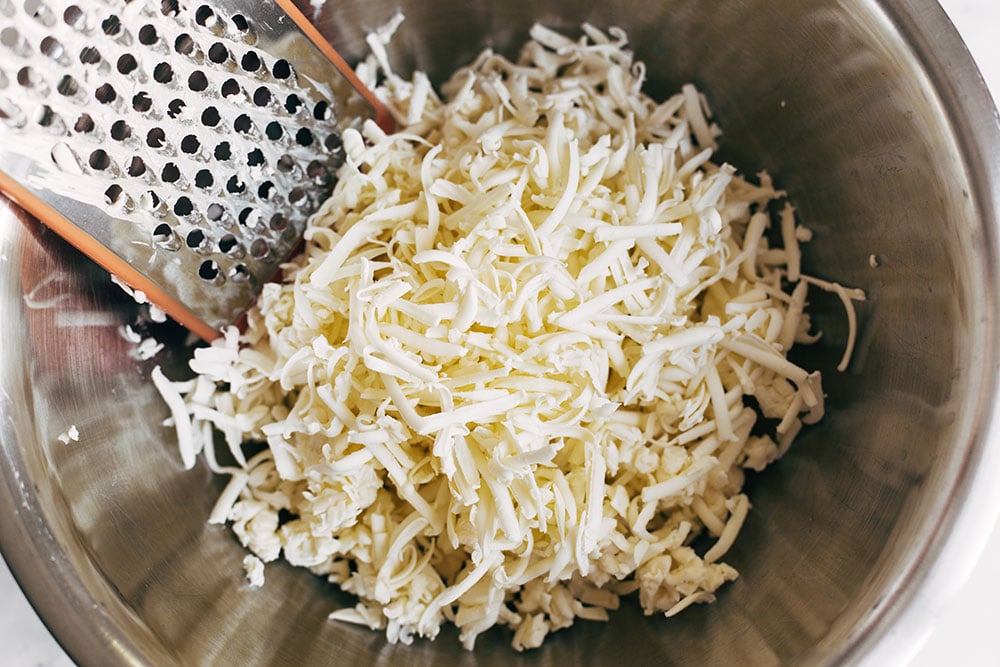
Method 1: Grater or Knife
Take your butter and freeze it for about 10 minutes, or until it’s super cold and firm. Using the large holes on a grater, literally grate the butter like cheese. If you have it, you can use the grater attachment on your food processor, but otherwise use the large holes on a box grater. Return the grated butter to the freezer for another 10 minutes until it’s firm before adding into the flour mixture.
If you don’t have a box grater, freeze your butter for even longer, until firm, then use a sharp knife or bench scraper to slice it into chunks.
Working quickly, use your hands to further cut and break the butter into pieces the size of small peas. You can also use a pastry cutter/blender or two knives.

Method 2: Food Processor
Since I live in Phoenix where temperatures often exceed 85°F, I typically use a food processor to make pie dough. It’s quick, easy, and prevents the butter from warming up too much. Cube your sticks of butter with a bench scraper and freeze until firm. Add into the dry ingredients in the bowl of the food processor with the butter and pulse until the butter is the size of peas.
You want the butter to end up the size of little peas. This will help bring the dough together cohesively without overworking it.
Overworking the pie dough develops more gluten, which can make the baked crust tough and dense instead of light and flaky. This can also cause the crust to shrink while it’s baking. Additionally, overworking the dough with your hands can start to melt the butter, preventing that flaky texture from forming.
Creating pea-sized bits of butter will also prevent the butter from pooling into greasy puddles as the pie bakes. I used to use larger chunks of butter and would encounter these grease pools too often, so I’ve scaled back to much smaller pieces.
How Much Water to Use For Pie Dough?
This is one of the trickiest parts of making pie dough. The reason is that many factors affect how much ice water you’ll need to add, such as the climate and humidity of your kitchen and the brand of flour you’re using. That’s why the recipe calls for a range of water. Add half of the total amount to start with. Toss it in to combine either by hand or with a few pulses of the food processor.
Pick up a piece of the mixture and pinch it between your fingers. It should hold its shape. If it crumbles away or seems really floury and dry, then you need to add more water.
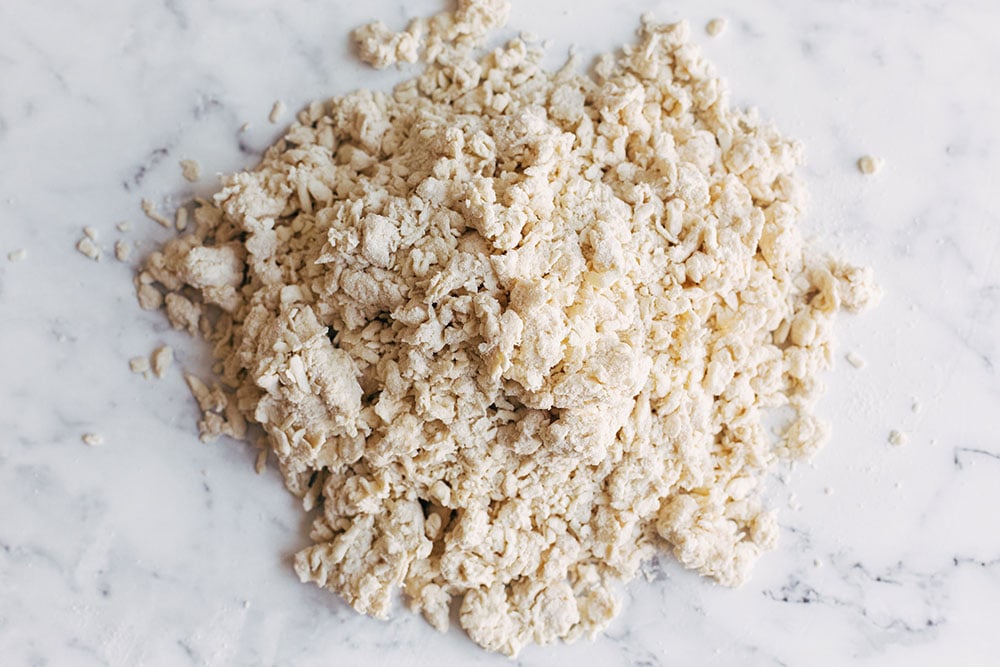
At this point, I like to turn the mixture out onto a work surface and begin pressing it together into one messy lump of dough. Doing so will give you a better indication if you need to add more water.
The dough won’t look like much at first. It’ll be kind of craggly and messy looking, and that’s okay.
Once you have a fairly cohesive mound of dough, flatten it into a disk and fold it onto itself, kneading gently as you work.
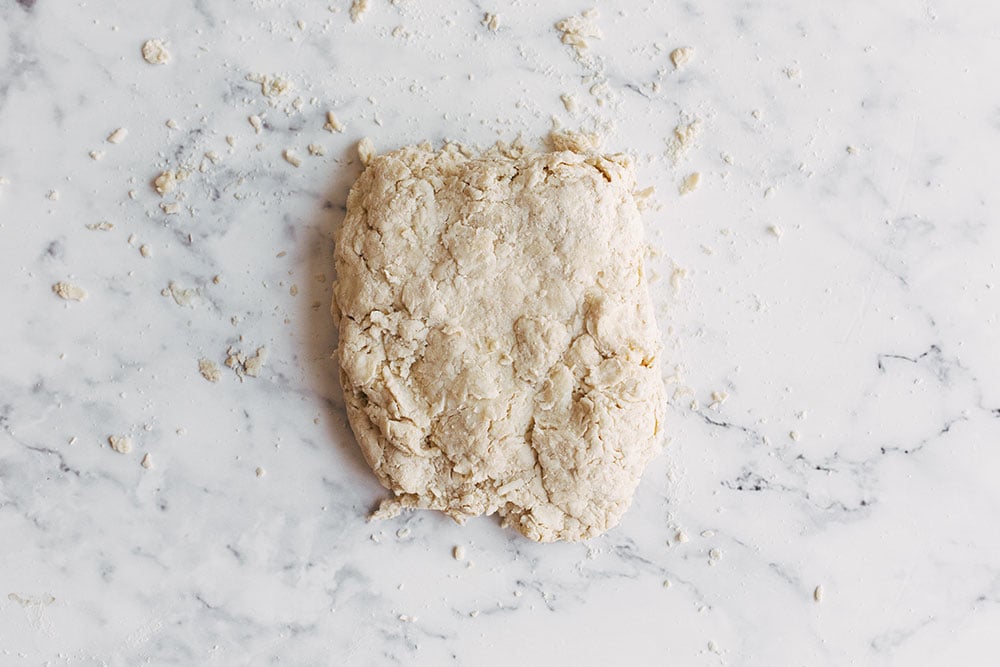
Do this a couple of times to ‘laminate’ the dough. Every fold will give you more flaky layers. Just be careful to be gentle and work the dough only until it comes together into a smooth cohesive disk like this:
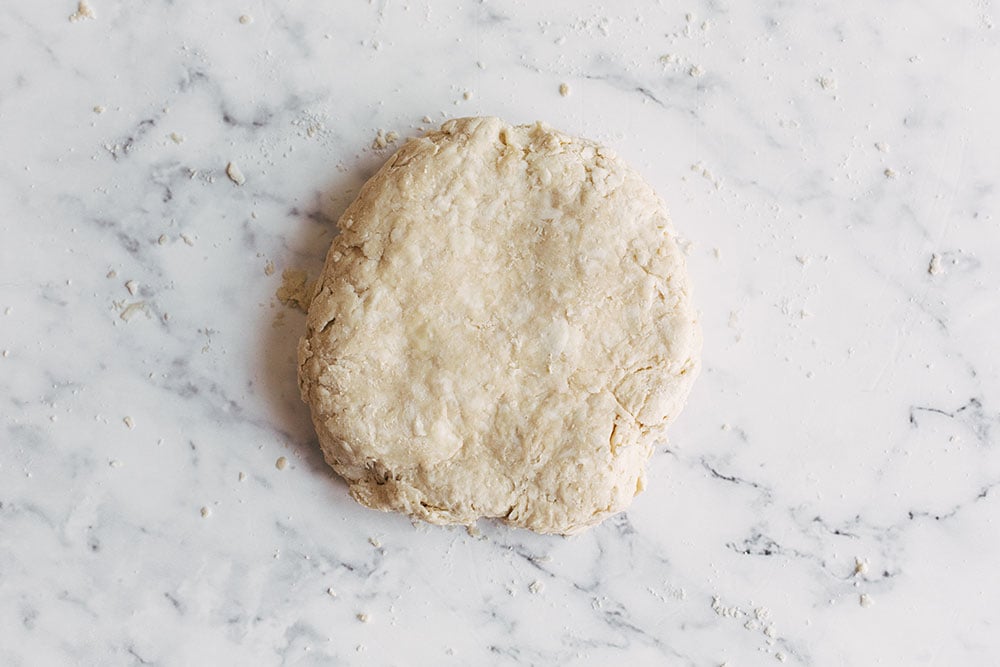
If you were to cut the mass in half, such as for a double-crust pie, you can visibly see the layers of butter thanks to that extra folding step. These layers are going to bake into crispy, tender, flaky goodness:

Give the Dough a Rest
If you have problems with your crusts shrinking while baking OR if your crust becomes tough, then it needs more time to rest so the gluten can relax so it doesn’t snap back to its original smaller shape. I’ve included these resting periods in the recipe directions.
After mixing it: wrap it in plastic and refrigerate overnight. You can shorten this to a few hours if you must, but I find overnight really makes a difference in preventing classic pie issues.
After rolling it out: let it rest in the fridge after you’ve rolled it out and placed it in the pie dish and/or after you’ve assembled. Do NOT stretch the dough to fit into the tin, as it will snap back like a rubber band while baking.
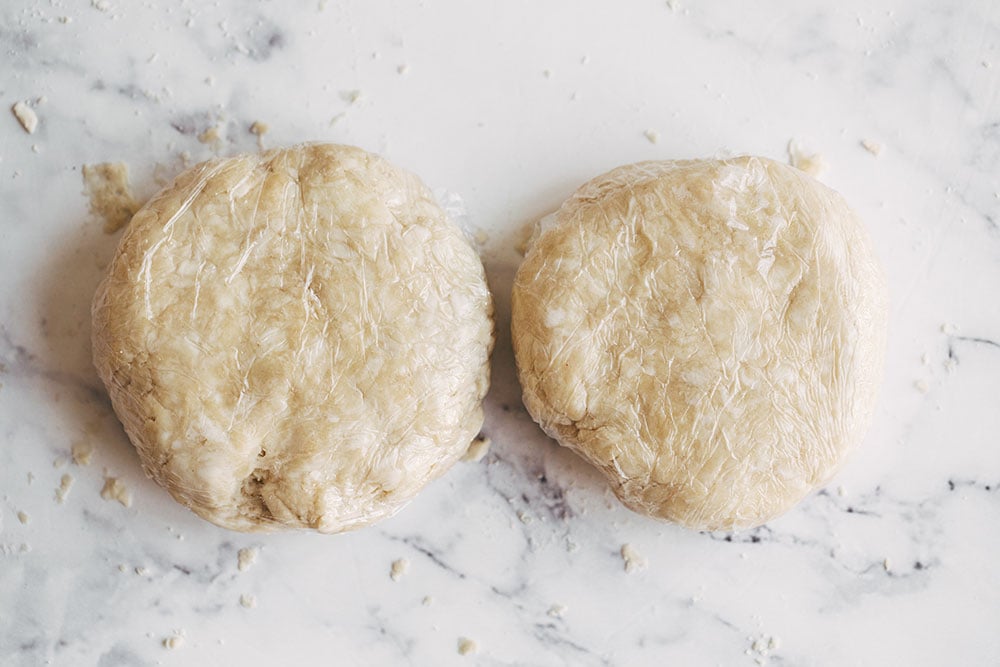
Now let’s move on to the other area of pie crust that I think frustrates a lot of people.
How to Roll Out Pie Dough
I typically roll out my dough on a marble pastry board, but that is totally optional. You can use the trick I mentioned above of icing down your counter before rolling to help keep things nice and cool. Avoid overworking the dough as you roll it out. Keep the dough moving on a lightly floured surface so you don’t roll over the same areas repeatedly, making it tough.
You’ll want about a 12-inch diameter for a 9-inch pie pan. Some pans are deeper than others, so factor that into your rolling. Whatever you do, make sure the thickness is about 1/8-inch for your pie crusts. Thinner will result in rips and tears. Thicker and it won’t cook through and get flaky.
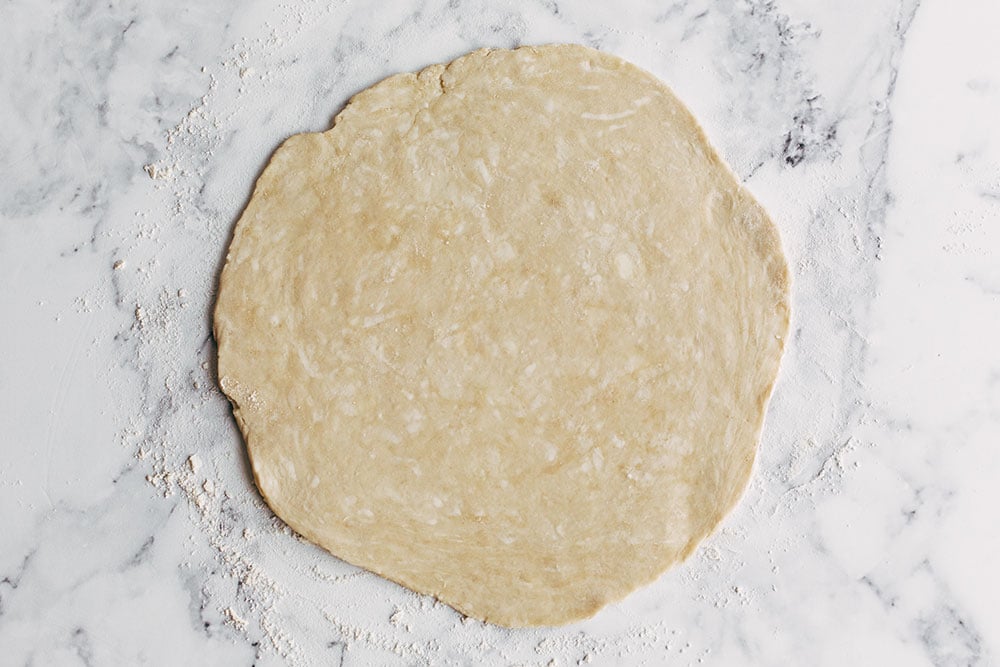
Flour your work surface, the dough itself, and your rolling pin throughout the process as needed. There are two inexpensive tools that I find are both a MUST when it comes to rolling out pie dough: a flour shaker and a bench scraper.
The flour shaker allows you to easily add flour wherever sticking might be happening. The bench scraper allows you to easily keep the dough moving as you roll it out, which is essential. I keep the dough moving in quarter-turns to prevent sticking and to keep it an even thickness.
Alternatively, you can roll the pie dough out between two sheets of parchment paper or plastic wrap. I find that most non-commercial paper and plastic wrap isn’t big enough to accommodate a 12- to 14-inch diameter circle, so I don’t often use this method.
If at any point the butter begins to get melty and sticky, return the dough to the fridge immediately.
Use your fingers to flute the edges of the pan if you wish. I find that I need to make a more dramatic flute than I might think since the design will loosen during baking. Whatever you do, don’t make the flute too thick and heavy, otherwise it’ll slump down the sides.
More Dough Than Other Recipes?
You might notice in the recipe below that I call for more ingredients than other recipes. This is because I think it’s easier to work with dough when you have a little more than you may need. It comes together more cohesively and if you get any rips, tears, or make any mistakes with a design, you have extra.
This especially comes in handy if you have a deeper pie dish or if you want to get fancy with any designs.
Pie Crust: Butter vs. Shortening?
I’ve done an extensive amount of testing on pie crust. Let’s just say my kitchen has seen a LOT of butter. I made the messes and did the testing so you don’t have to. Here’s what I learned.
When it comes to pie dough, I’ve heard a lot of confusing and conflicting opinions about which is the better fat. If you’re curious, you can learn more about the general differences between butter and shortening here. But I actually tested the two fats in pie crust side-by-side to compare. I still need to do testing with lard, so stay tuned for that!

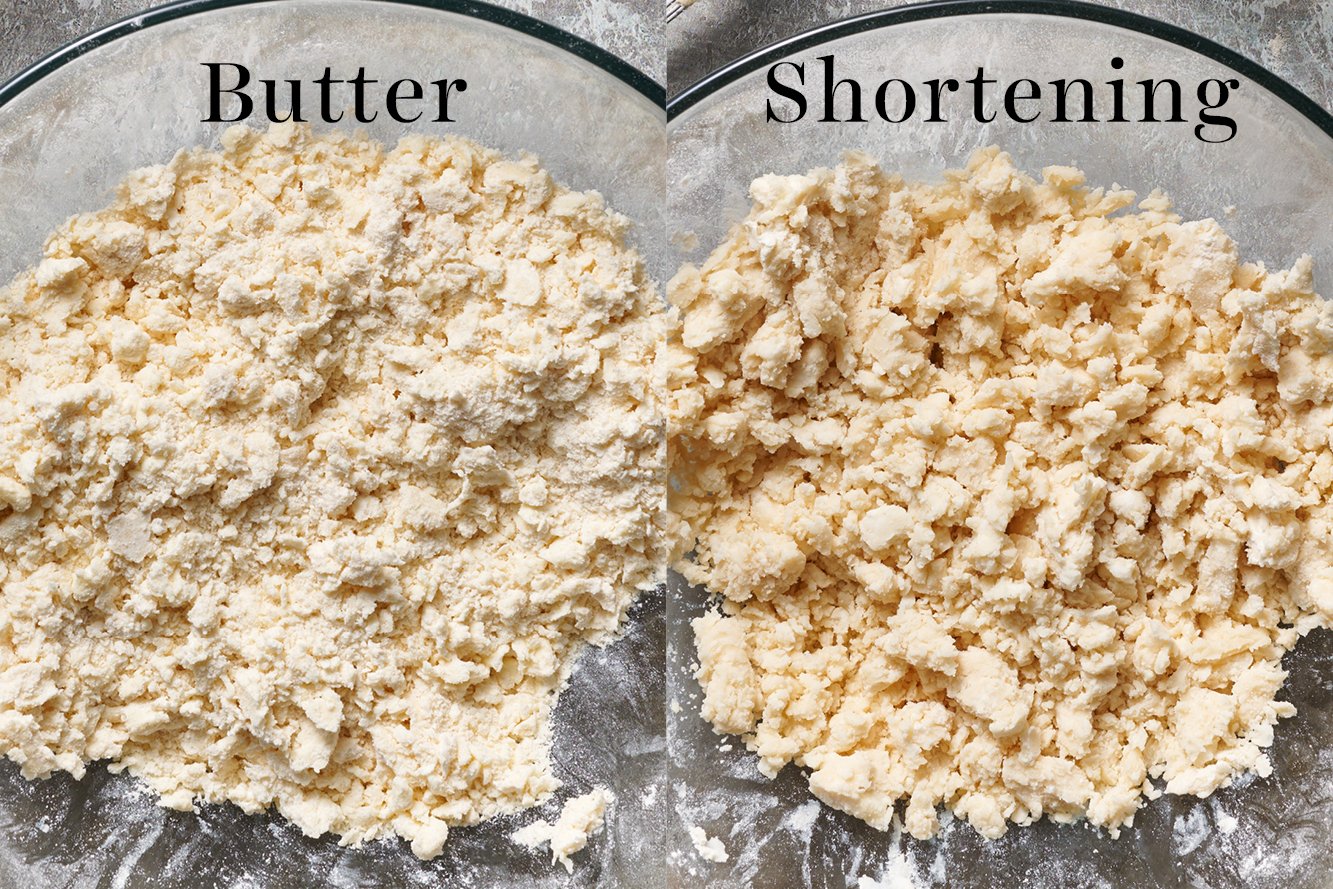
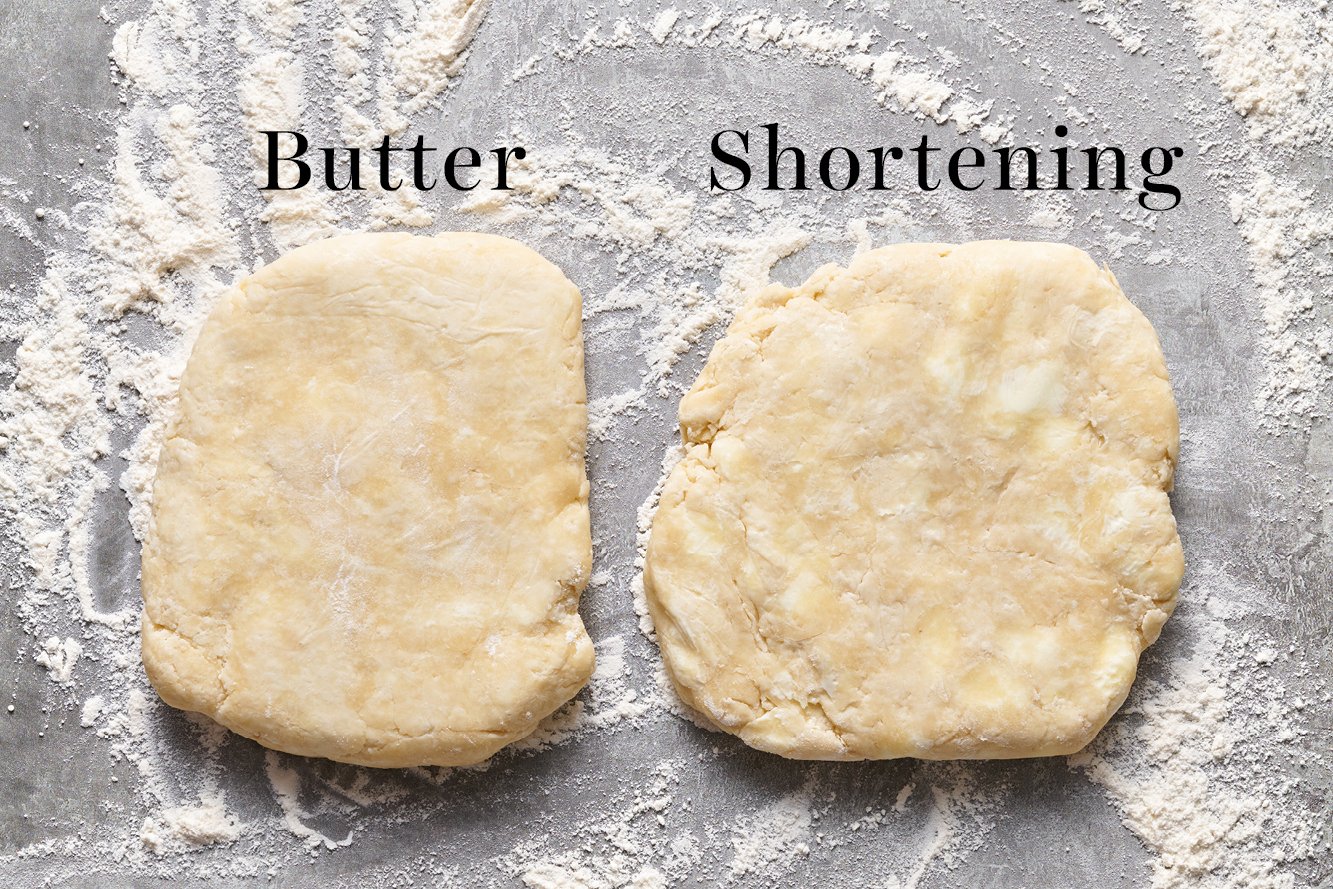
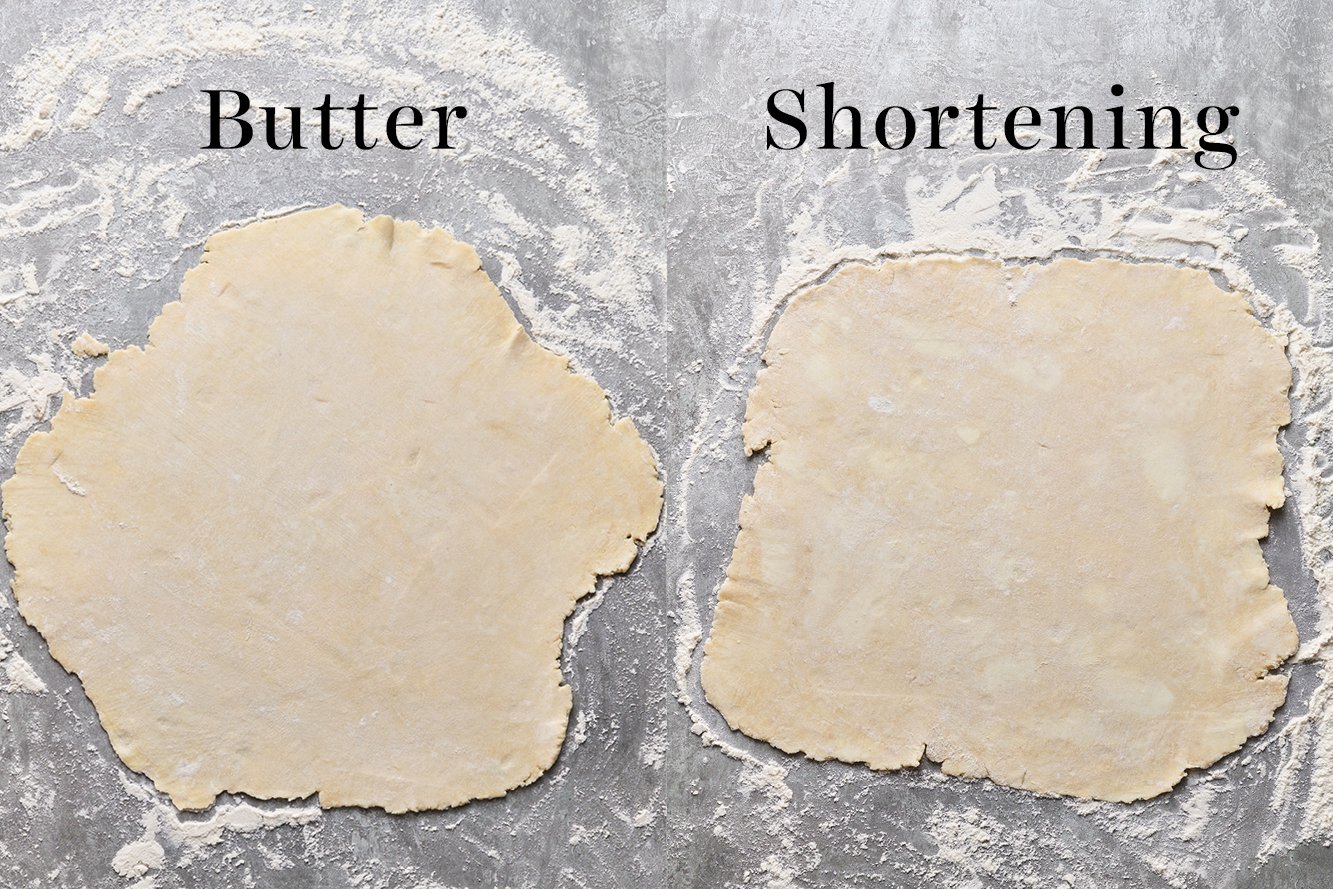

Shortening
All-shortening dough can be easier to work with in one sense because unlike butter, shortening requires less chilling time. Shortening has a higher melting temperature than butter. However, this also means that unlike the very hard chunks of cold butter that remain in the control dough, shortening is soft enough that it is easily overworked, resulting in a crumbly crust instead of a flaky crust. In our blind-baked shortening crust, the parchment paper holding the pie weights actually stuck to the crust, pulling some of it off with it.
As you can see in the photograph, the all-shortening dough ended up being flat, tender, and fairly crumbly. The texture was actually reminiscent of shortbread, and it was completely lacking in flavor. In fact, the flavor reminded me of store-bought dough.
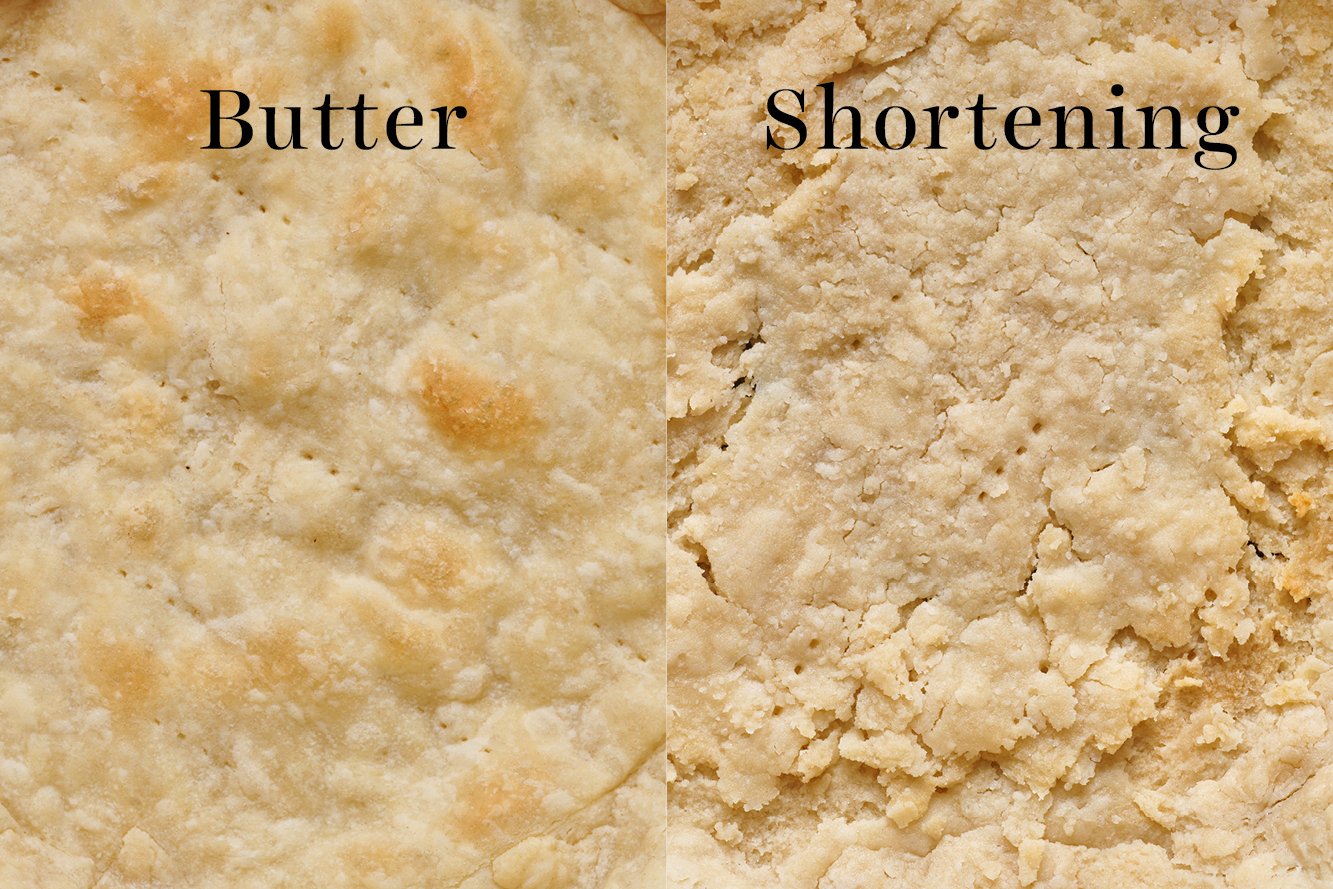
Butter
In this all-butter dough, there were plenty of visible chunks of butter studded throughout. Once it came together and was chilled, it was a bit of a challenge to maintain that perfect temperature where it’s warm enough to shape but cold enough that the butter doesn’t melt. Especially for me living in the desert. The extra effort paid off immensely, though. This pie crust was ridiculously light, flaky, and loaded with rich buttery flavor. You could immediately tell this was homemade, in the best way. This is why I almost always prefer a 100% butter pie crust.
If you like the benefits of shortening, then I’d recommend a 50-50 ratio of butter and shortening to get the best of both worlds.
Other Pie Crust “Tricks” Put to the Test
Vodka in Pie Crust?
A few reputable sources have claimed that by substituting a portion of the water with vodka in a pie crust recipe, you prohibit gluten development and therefore ensure a tender, flaky crust. I tested this against my standard pie crust recipe and found the differences to be slight. I don’t think it’s worth the extra effort if you don’t have chilled vodka on hand.
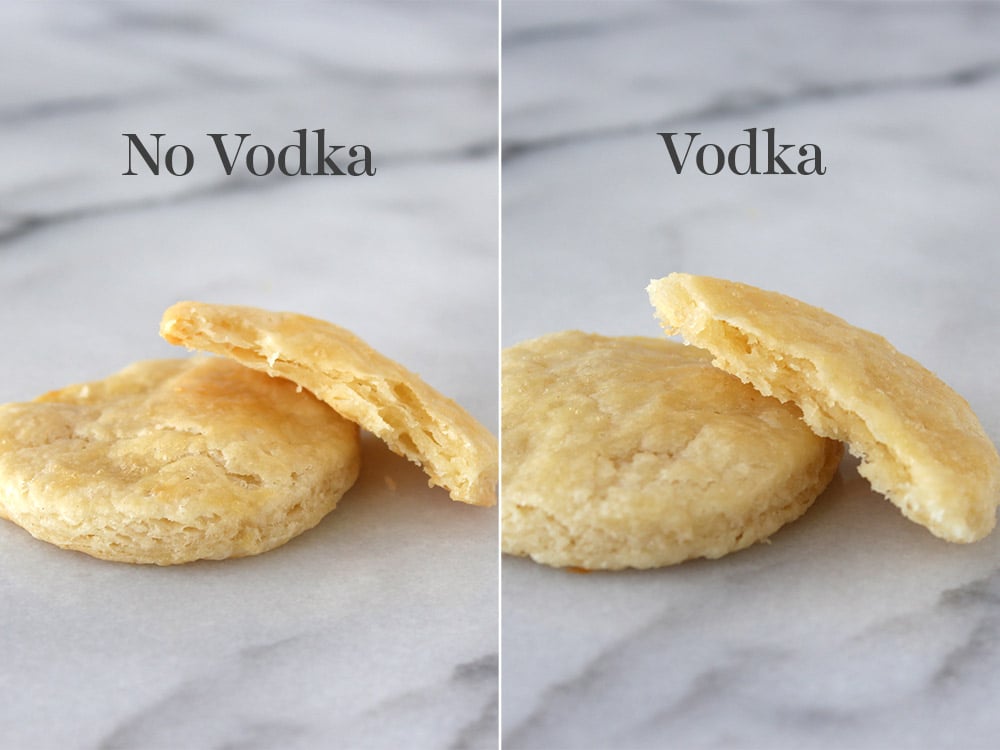
Optional SECRET Ingredient!!
As you can see, I’ve done a lot of side-by-side testing of pie crust variations. Most of the time the classic recipe has won out, with a single exception: SOUR CREAM!
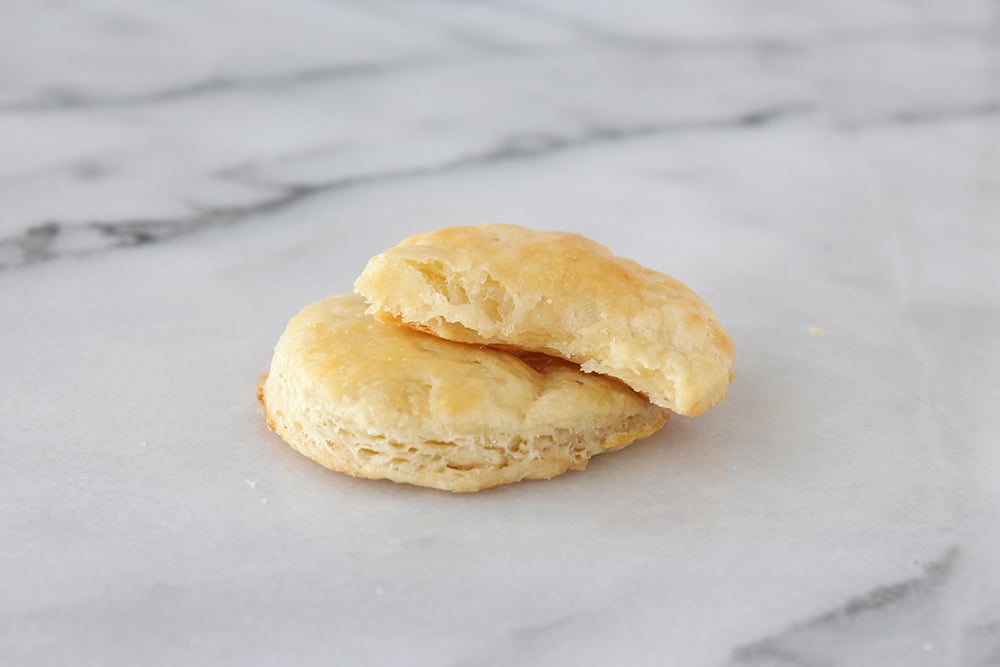 Sour cream acts as a tenderizer in baked goods, and I was curious to see if it would significantly affect the texture of pie crust.
Sour cream acts as a tenderizer in baked goods, and I was curious to see if it would significantly affect the texture of pie crust.
- I added 2 tablespoons of sour cream to my standard single recipe along with the butter.
- This dough was very soft and slightly sticky, but easy enough to work with.
- The texture was ultra-light, puffy, and flaky, almost like puff pastry.
- This pie crust puffed up to a surprising height.
- If you have sour cream handy, I definitely suggest giving it a shot.
How to Add Sour Cream
Add in 2 tablespoons to the single recipe below, and reduce the water by about 2 tablespoons, or as needed.
Can you Make Pie Dough Ahead of Time?
Yes! Here are your options:
1. Chilling the dough disk: Pastry dough can be shaped into a disc and refrigerated for up to 3 days, as long as it’s well wrapped in plastic.
2. Chilling the unbaked pie shells: Refrigerate for up to 3 days. Simply roll out your dough, lay it into your pie tin, crimp the edges, and cover loosely with plastic wrap. When ready, simply remove from the fridge, fill, and bake. This works perfectly for single-crust pies like pumpkin or sweet potato.
3. Freezing dough: Pastry dough can also be shaped into a disc and frozen for up to 2 months, well wrapped in plastic, and placed in a freezer bag or airtight container. Defrost in the fridge overnight before rolling out.
4. Freezing pie shells: Unbaked pie shells can also be covered and frozen for up to 2 months. No thawing necessary.
How to Bake Pie Dough
I’ve included instructions on how to blind-bake the crust for recipes that require an already-baked crust. Otherwise, just follow the directions in the pie recipe you’re following for baking the crust – or, check out my full article on How to Blind Bake Pie Crust here!
The Best Pie Pan for the Best Pie Crust
The material of your pie pan can make a big difference in how your pie bakes. I recently used this Best Ever Pie Crust recipe to experiment with different pie pans, to determine which pie pan is best. Check out my Best Pie Pan article here to see my side-by-side experiments using glass, ceramic, metal, and disposable pie pans, and learn which pie pans I recommend.

Expert Tip!
Place your pie pan on a rimmed baking sheet before putting in the oven. This helps you to remove the pie tin without damaging the crust with your oven mitts. Better yet? Place the sheet on a BAKING STONE to ensure a golden crispy bottom crust and avoid any sogginess.
Take a look at these pies using this recipe, all made by HTH community members – many of whom had previously struggled to master pie dough! Follow the tips in this article to bake pies that look like these:


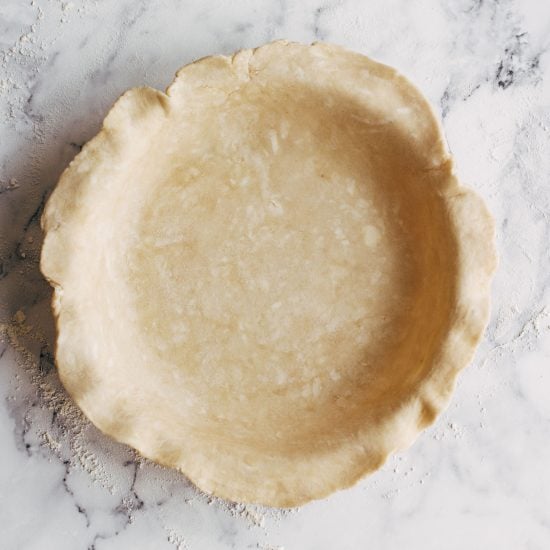



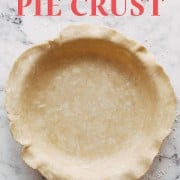

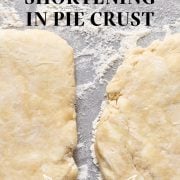
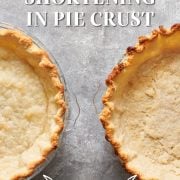

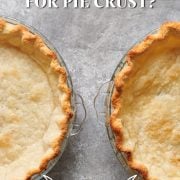
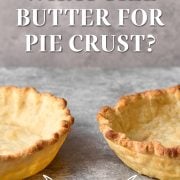
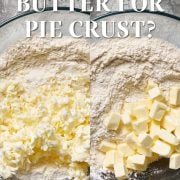

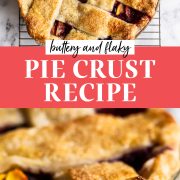

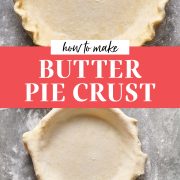
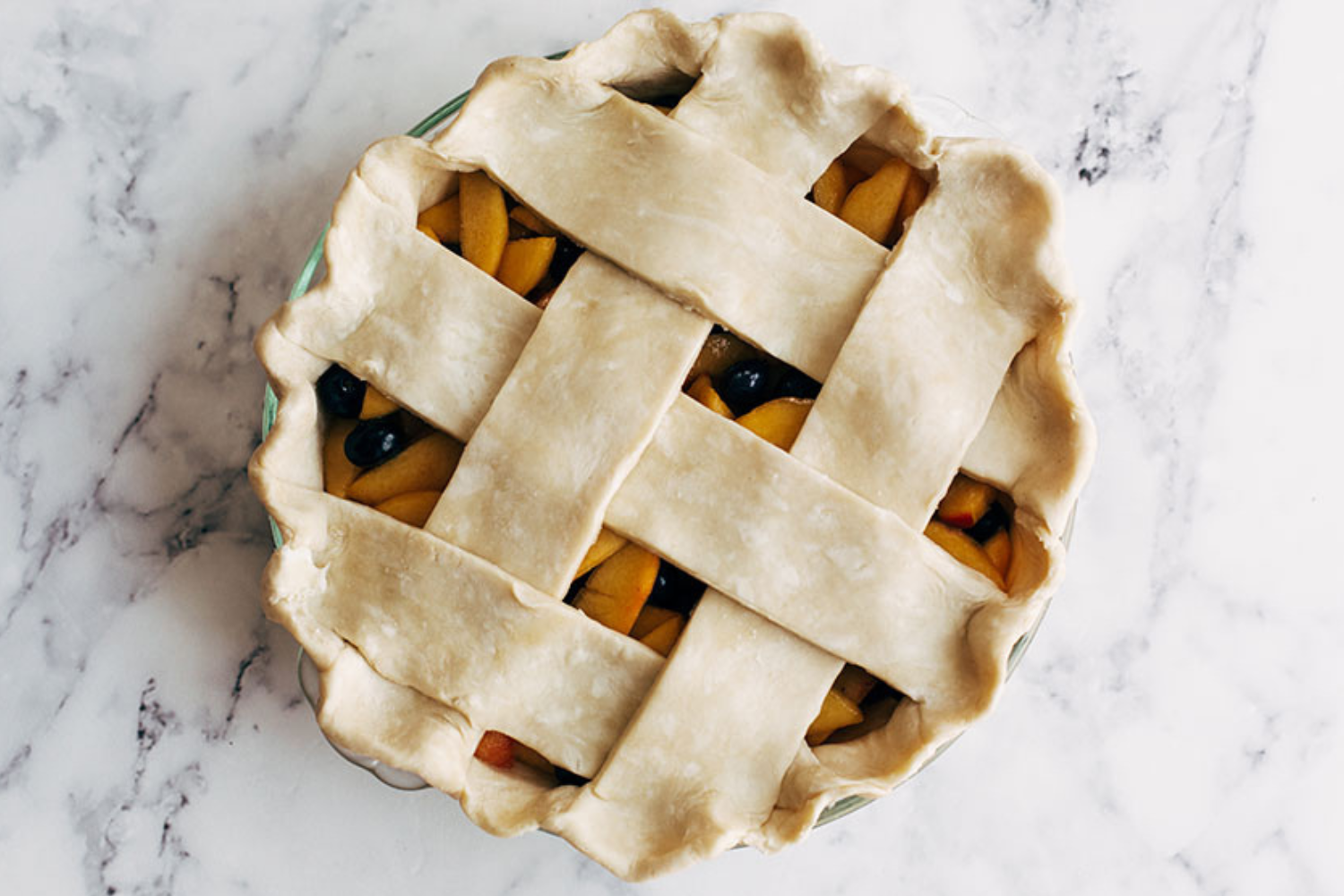
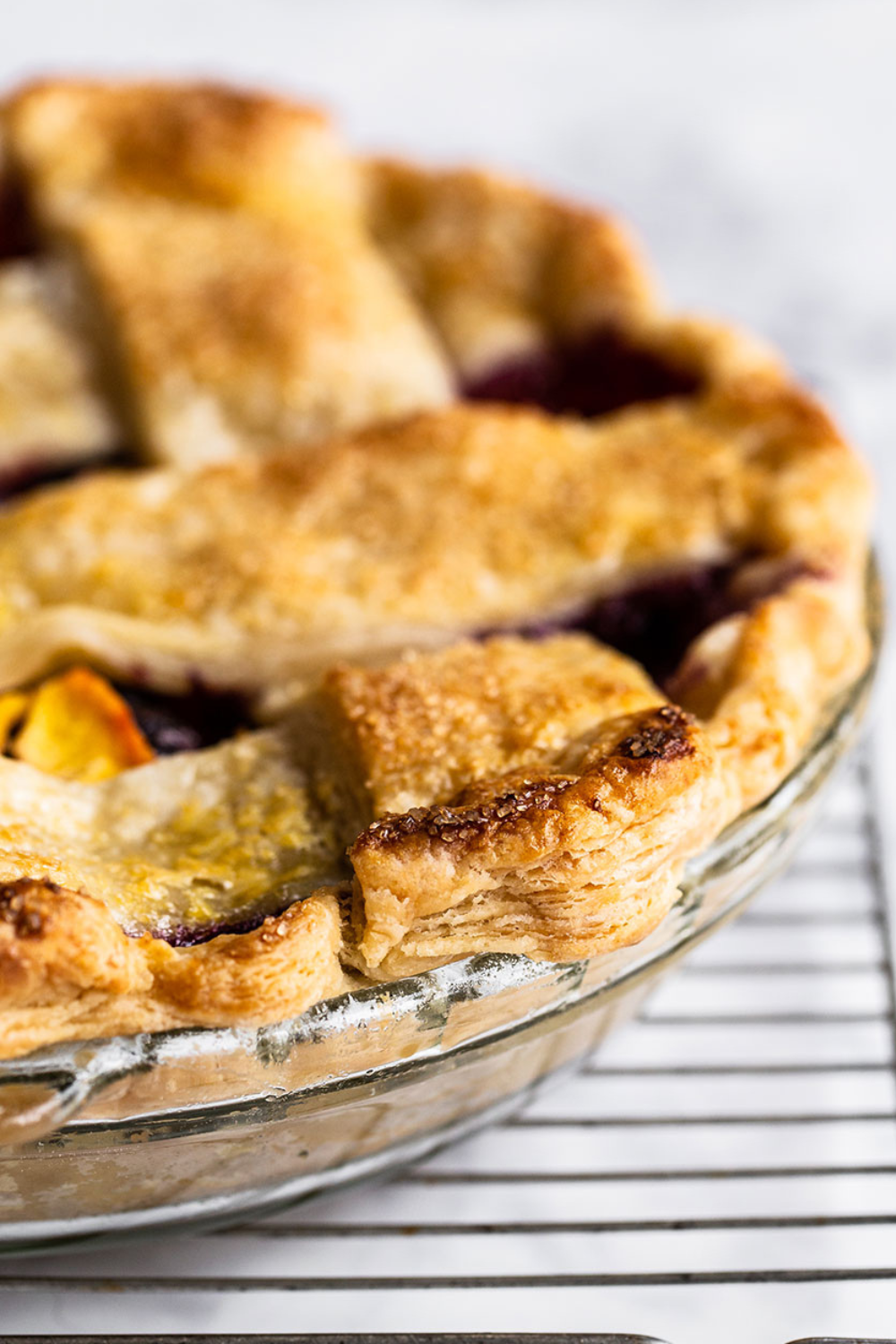





















 Sour cream acts as a tenderizer in baked goods, and I was curious to see if it would significantly affect the texture of pie crust.
Sour cream acts as a tenderizer in baked goods, and I was curious to see if it would significantly affect the texture of pie crust.
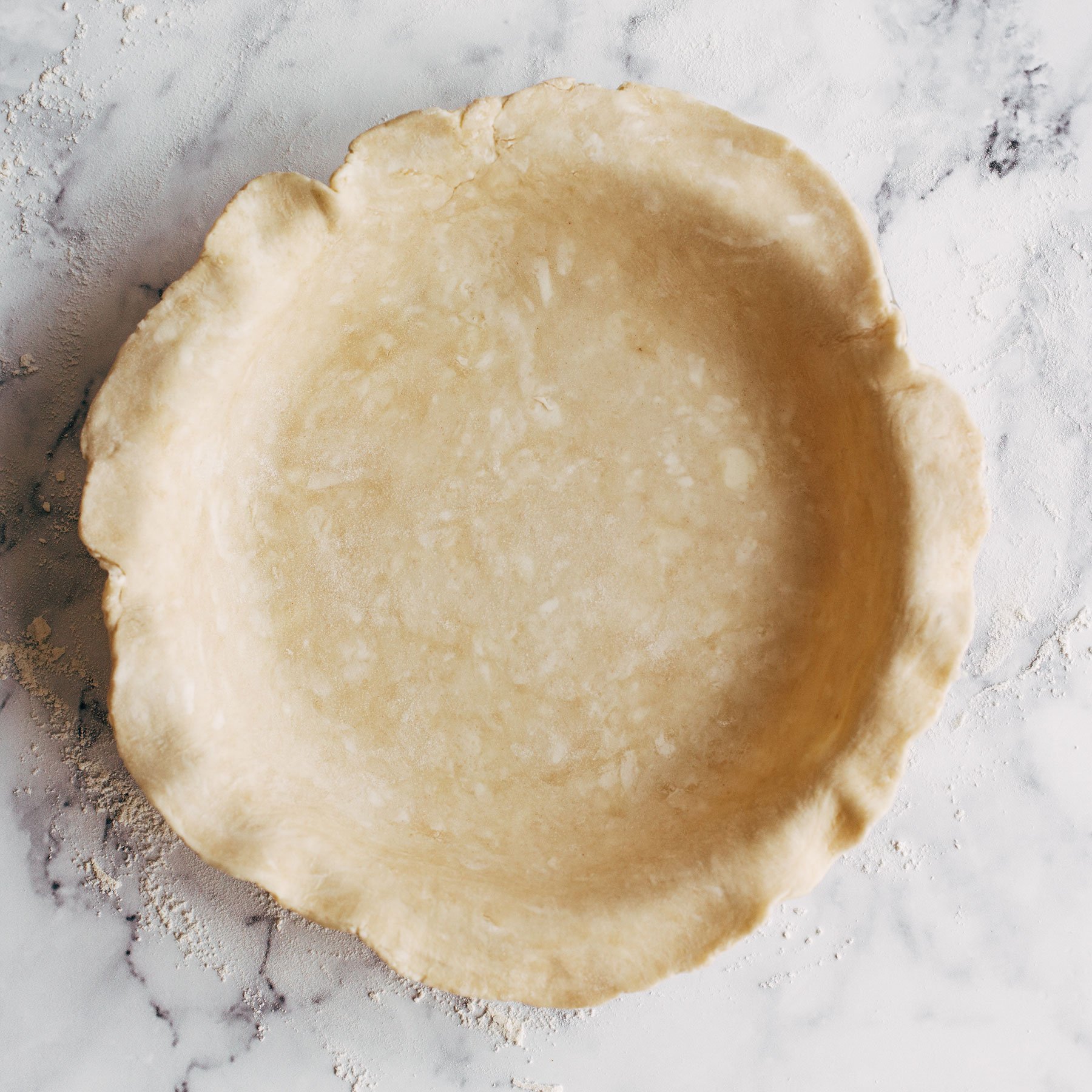


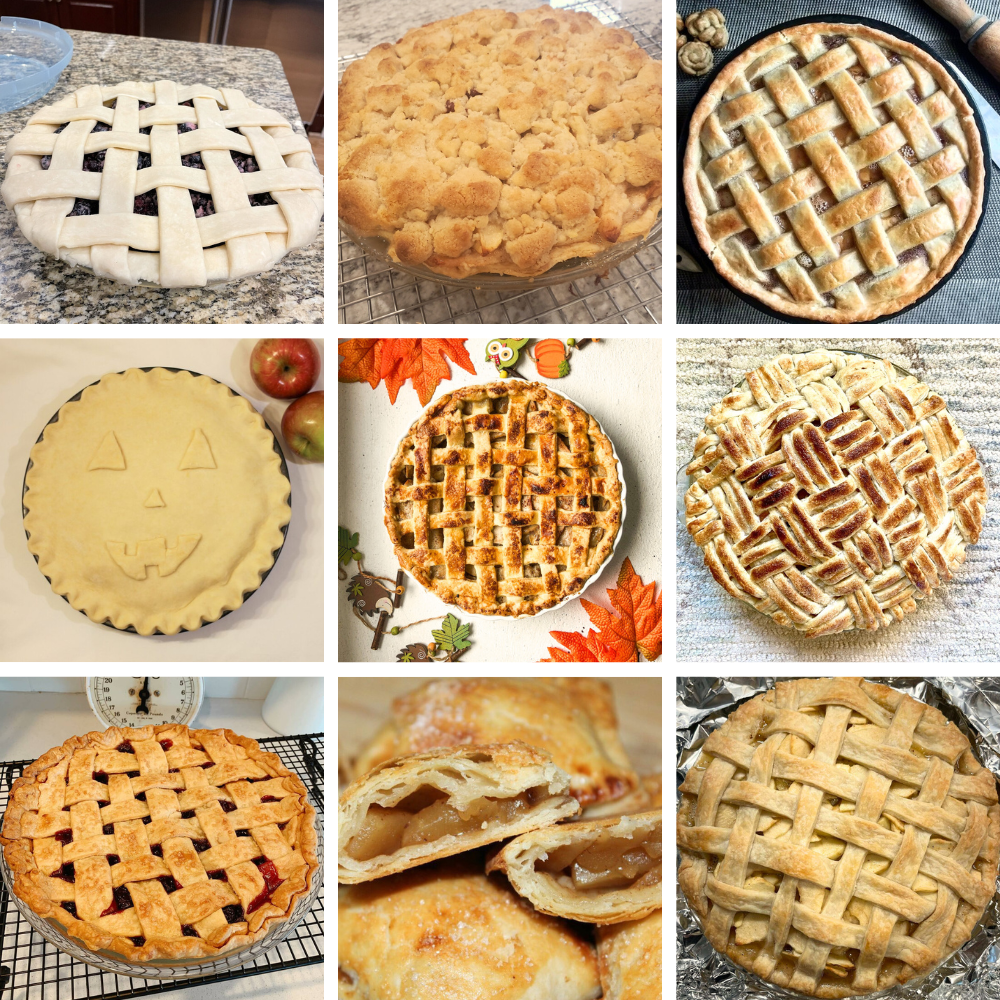



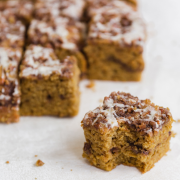
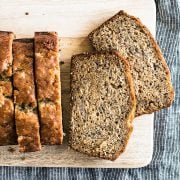
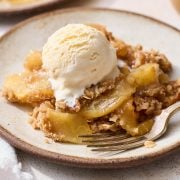
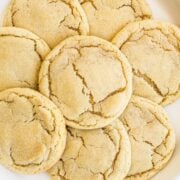
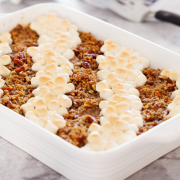

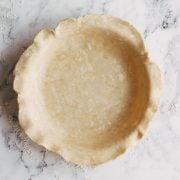
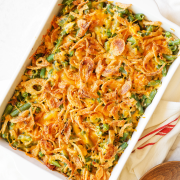
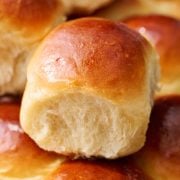
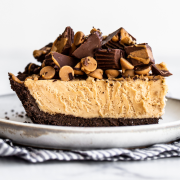
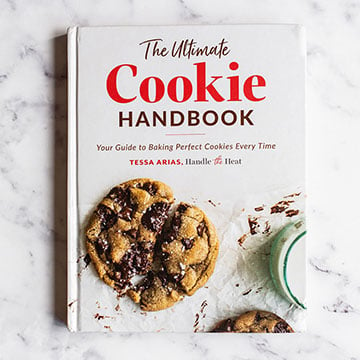
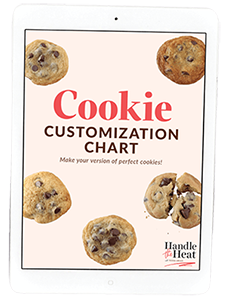
Thank you so much for all your recipe. and valuable information. I feel I’m finally ready to make my own pie crust in time for Thanksgiving. God bless you!
Woohoo! Can’t wait to hear how it goes 🙂
Hi, I love these pie crusts. Thanks for the recipe! I’ve only used them for a quiche (crust was parbaked) so what would you recommend for a pot pie that I will immediately freeze? Do I roll out the dough, fill with chilled pot pie filling, top with second crust and then bake before freezing, or freeze unbaked? What would your baking recommendations be if reheating a frozen baked pot pie, and what would your baking recommendations be for baking a frozen unbaked pie? Thanks so much and I’ll make sure I report back with the results.
P.s. my mother in law who is the quiche expert said that my crust (and quiche) was the best she had ever had so that’s a huge win!
Hi Demi! We’re so glad to hear that you enjoy this pie crust recipe, and woohoo for mother-in-law praise!! 🙂 We haven’t tried using this recipe to make a pot pie, and Tessa’s Chicken Pot Pie recipe here uses homemade biscuits on top, rather than encasing the pie filling entirely in crust (an easier and equally delish alternative). When using this pie crust recipe to make an apple pie, we’ve have had success freezing the fully-assembled but unbaked pie, allowing it to thaw at room temperature for an hour or two, and then baking on top of a baking tray. Depending on how deep your pie is, and your oven (as all ovens are a little different – learn more about ovens here!), and how thawed your pie is when it enters the oven, you’ll likely need to add about 30-60 minutes to your bake time. I hope that helps! Can’t wait to hear how it goes 🙂
I made this and the sides of my pie crust shrunk in and didn’t stay upright! Anyone else had this happen??
Hi Laura! There are a few reasons this can happen. Firstly, did you rest your pie crust as the recipe instructs? As Tessa mentions in the pink tip box (above the recipe), “If you have problems with your crusts shrinking while baking OR if your crust becomes tough then it needs more time to rest so the gluten can relax so it doesn’t snap back to its original smaller shape.” The dough needs to be rested right after it’s made, and again after it’s been rolled out. Also, be gentle when placing your rolled-out dough in your pie pan, as pulling and tugging at the dough will have the same results and the dough will snap right back and shrink as it bakes. Finally, if you’re blind-baking or par-baking your crust, be sure to fill the crust all the way to the top with pie weights, to avoid the crust shrinking and/or slumping. Learn more about that here. I hope this helps, and I hope you’ll try this pie crust again – it really is delicious! Happy baking 🙂
I may have missed it, but was there any testing done using 1 Tbs of white vinegar in the cold water added to the dough? Thank you!
Hi Nancy! Tessa has experimented with just about every other pie crust variation there is, but not vinegar! Feel free to experiment with this as you like, but this recipe is phenomenal as-written, so we hope you give it a try!! Happy baking 🙂
Do you recommend allowing an unbaked single-crust pie shell to come to room temperature before filling and baking it, or is it advisable to yank it straight out the the refrigerator, fill it, and shove it in the oven? It seems like one or the other would have a definite effect on the results.
Hi Minerva! It depends on the recipe you’re making as to whether or not you’re first blind-baking or par-baking your pie crust – but either way, we recommend always going straight from fridge to oven where pie crusts are concerned. The colder the butter, the better the flaky outcome of the crust. Allowing the crust to come to room temperature will soften the butter, so it will melt much faster in the oven, losing those nice steam pockets that create a flaky crust and even causing a soggy bottom on your pie. I hope that helps, Minerva! Happy baking 🙂
Hi Tessa,
I have been looking for a great recipe and I think this one makes the most sense. I’m going to try it with the sour cream suggestion, but I was wondering if you have ever tried this with a stand mixer and a pastry blender attachment? I like the no mess and visibility of a stand mixer, and I also find I can double my pie crust recipes easier (if I am making pies, I might as well make a few and freeze them for later). Much appreciated in advance!
Hi Demi! We haven’t tried making this recipe in a stand mixer, but please let us know how it goes if you do!
My mother is shining down on me from Heaven! I finally successfully made a homemade pie crust! I feel pretty certain that she guided me through the inter-webs to this very page! Now to master folding the fitted sheet …
so what type of baking pan would you recommend using? glass, ceramic, or aluminum?
Hi Angel Marie! This is the last thing Tessa talks about in the pink tip box above the recipe. She discusses metal, glass and ceramic pie pans, and the pros and cons for each. I hope that helps 🙂
yes I read about the pros and cons. but I was just wondering what she uses or recommends would be the best.
Hi Angel Marie! Tessa believes that each pie pan type has pros and cons, as you saw above, so it’s helpful to have at least two of the options depending on your preferences and needs. Each pie type will have different needs, so it also depends on the type of pie you’re making. For steady heat conductivity for light, flaky crusts, aluminum is a great and cheap option, so if you’re just starting out, this is a great place to start. I hope that helps 🙂
Hello, I have a pecan pie recipe I’m trying to make for Christmas this year and want to use this crust recipe, the pie recipe calls for 50 to 60 minutes in the oven at 350, would this be doable for the crust or should I bake the crust and filling separately somehow and add it to crust once done? Thanks!
Hi Monica! No, don’t try to bake separately. That should work fine – but depending on how wet your pecan pie recipe is, you might want to read over this post on how to blind-bake your pie crust first. Let us know how it goes 🙂
This is bar-none the finest pie crust recipe I’ve tasted/baked in my 73+++ years on this earth. I have eaten pastries all over the world as a former commercial/corporate/private flight attendant who had no limit on my catering budget. The looks on my friends’ faces at Thanksgiving were amazing!
Thank you Tessa for all your hard work…I just wish I had found you sooner!
What a lovely message, Fay! We are so thrilled that you enjoyed this pie crust recipe so much. Can’t wait to hear what you bake up next 🙂
I have not made this yet but can say, I study a lot of pie recipes looking for what I think might be best. This is by far the most clear, concise, complete recipe I’ve seen, and will in the future follow every single step of it. Thank you very much.
So glad to hear that Tessa’s tips and info will be so helpful for you, Maxine! Thanks so much for the comment 🙂
My 13 year old son made his first pecan pie using this crust! It’s perfect!
Wow, that’s impressive! I think your son might be a Master Baker in the making! 🙂 So glad this recipe worked out well for him!
Please have a printable recipe that I can take to the kitchen and follow instead of running back and forth to my computer in the den and the kitchen.
Hi Roberta! There is a printable version available. Look at the very top of the page, right below the recipe blurb and the Yield and Prep Time information. You will see a little red printer icon. Simply click that for the printable recipe on any of our recipes. I have included this pie crust recipe’s printable page, for your convenience. Happy baking!
I feel like I have followed this recipe step by step. I have made maybe 12 pies with this crust and I have the same problem every time. It so hard and tough. It is flakey but not tender, its so crispy even though its barely golden brown. The flavor is on point I just don’t know what it going wrong.
Hi Ashley! It sounds like your pie crust might be getting overmixed/overworked. Overworking the dough will result in the pie crust becoming hard and tough. Also, if you are using King Arthur all-purpose flour, that particular flour has a higher protein content, so can make it a little easier to accidentally over-develop the gluten while mixing. Also, be sure to use a digital scale to measure out your ingredients, to ensure you’re not adding additional flour accidentally. If you haven’t already, read through all of Tessa’s wonderful tips and tricks above the actual recipe on this post, so you can arm yourself with as much info as possible, before tackling your pies again! Good luck! 🙂
Do you have a shortcrust pastry recipe?
Hi Abby! We have a Tartelette Crust / pâte sablée recipe here. I hope that helps! Happy baking 🙂
Thank you!
Hi! Will this recipe have enough dough for a deep dish glass pan?
Hi Mary Anne! As Tessa mentions in the Tip Box above the recipe, this recipe does make a little more dough than most standard recipes, so as long as your pie plate isn’t too much larger than standard (8-inches or so), you should definitely have enough dough for your deep dish pan. Let us know what you think once you’ve given this pie crust a try! Happy baking 🙂